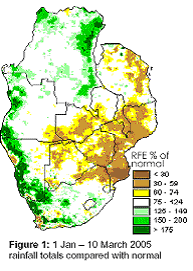| |
Back to Index
Regional Food Security Programme Special Agromet - Update: 22 Mar
2005
Relief Web
March
22, 2005
http://www.reliefweb.int/rw/RWB.NSF/db900SID/RMOI-6B98JU?OpenDocument&rc=1&cc=zwe
Download
this report
- Acrobat
PDF version (317KB)
If you do not have the free Acrobat reader
on your computer, download it from the Adobe website by clicking
here.
Rainfall
Performance
Despite
a good rainfall performance in many parts of the SADC region in
the first half of the rainfall season, the second part of the season
has been characterized by poor rains in a large part of the southern
half of the region. Apart from some of the northern areas that experience
two seasons annually, the rainfall season in much of the SADC region
commences in October/November and terminates in April/May. During
the 2004-2005 agricultural season, the rainfall commenced on time
in the northern parts of the sub-region while the southern parts
experienced delayed onset in parts of Botswana, Mozambique, Lesotho,
Swaziland, South Africa, Zimbabwe and Namibia. The rainfall improved
in November and December 2004 in most areas, and cumulative rainfall
up to December was satisfactory in most of the SADC region. Northern
South Africa, southern Zimbabwe, and some areas in southern Mozambique,
northern Botswana, Lesotho and Swaziland however had low rains during
this first half.

The second half
of the season (January up to current) experienced rainfall below
average amounts in some parts of SADC. Southern Mozambique received
less than 30% of normal rainfall (dark brown areas, figure 1) while
areas in parts of northern and eastern Botswana, central and southern
Malawi, much of Mozambique, southern and central Zambia, eastern
and southern Zimbabwe, northern parts of South Africa, parts of
northeast Namibia, and parts of Tanzania and received between 30-60%
of normal rainfall (brown colours, Figure 1). Parts of Lesotho and
Swaziland had poor rainfall distribution earlier in the year --
recent rains have brought their percentages of normal rainfall to
near-normal levels, although in many cases too late to revive affected
grain crops. Table 1 summarizes the rainfall patterns during the
January-March 10 period, as well as the potential implications of
the rainfall pattern on agriculture, for selected zones in the Member
States. The low rainfall received during this period was associated
with long dry spells of up to 20-30 days which occurred from late
January into February 2005, a critical time for crop development
Impact on
Agricultural Production
The
rainfall performance in much of the southern half of the region
has been quite poor during the second half of the season (Figure
1, brown colours). This has negative implications for cereals and
pulses, with pasture for livestock being affected in areas with
more extreme rainfall deficit areas and high livestock densities,
while roots and tubers are not likely to be affected. For maize,
the dry spells are likely to reduce yields by about 10-20% on average
in parts of central and southern Malawi, Mozambique and Zambia,
eastern and southern Zimbabwe, parts of Lesotho, northern South
Africa and Swaziland. In some areas though, the reduction in yield
could be even higher.
Where sorghum
and millet were planted, these were less affected by the dryness.
Pulses were also affected. However, some pulses had already reached
maturity by the time the dry spell started. Despite the recent dryness,
roots and tubers are likely to experience a minimal reduction in
yield. The situation may impact slightly on livestock in terms of
pasture availability, as pastures are more resilient than crops
in terms of surviving soil moisture deficits. However, areas that
have received less than 60% of normal rainfall will experience reduced
pasture availability especially where livestock densities are high.
South Africa
-- the biggest grain producer in the region, is having a very good
season in the main grain producing areas, and expects a bumper harvest
this production year; this is on top of the residual surplus from
last season. The surplus grain from South Africa could be sufficient
to meet the shortfalls likely to be experienced in other countries
this season. In most areas in the southern half of the region, the
season has progressed for more than three quarters of its normal
duration. Little rainfall is expected in these areas as the rainfall
systems are moving northwards. Even in the event of more rains in
the remainder of the season, most grain crops that have been affected
in these southern areas are beyond recovery.
However, pasture
for livestock will be improved by any anomalous rains. In the northern
half of the region, the season is still continuing. Forecasts are
calling for higher chances of good rains in these areas, which should
improve the current poor performance in some of these areas such
as northern Tanzania.
Download
full document
Please credit www.kubatana.net if you make use of material from this website.
This work is licensed under a Creative Commons License unless stated otherwise.
TOP
|

